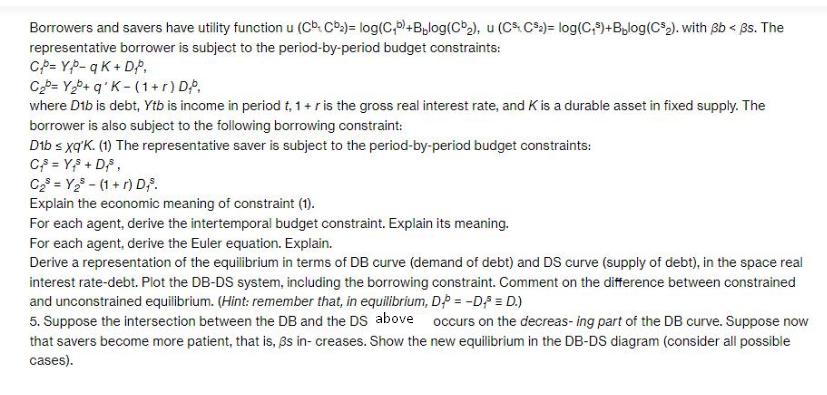Answered step by step
Verified Expert Solution
Question
1 Approved Answer
Borrowers and savers have utility function u (Cb, C)= log(C+Blog(C), u (CS. Ca)= log (C5)+Blog(C). with 3b < Bs. The representative borrower is subject

Borrowers and savers have utility function u (Cb, C)= log(C+Blog(C), u (CS. Ca)= log (C5)+Blog(C). with 3b < Bs. The representative borrower is subject to the period-by-period budget constraints: CP= YP-qK+DP, C Y+q'K-(1 + r) Dp, where D1bis debt, Ytb is income in period t, 1 + r is the gross real interest rate, and K is a durable asset in fixed supply. The borrower is also subject to the following borrowing constraint: D1b s xq'K. (1) The representative saver is subject to the period-by-period budget constraints: C = Y$ + D, C=Y - (1 + r) D.. Explain the economic meaning of constraint (1). For each agent, derive the intertemporal budget constraint. Explain its meaning. For each agent, derive the Euler equation. Explain. Derive a representation of the equilibrium in terms of DB curve (demand of debt) and DS curve (supply of debt), in the space real interest rate-debt. Plot the DB-DS system, including the borrowing constraint. Comment on the difference between constrained and unconstrained equilibrium. (Hint: remember that, in equilibrium, DP = -D = D.) 5. Suppose the intersection between the DB and the DS above occurs on the decreas-ing part of the DB curve. Suppose now that savers become more patient, that is, as in- creases. Show the new equilibrium in the DB-DS diagram (consider all possible cases).
Step by Step Solution
★★★★★
3.47 Rating (154 Votes )
There are 3 Steps involved in it
Step: 1
Constraint 1 represents the borrowing constraint for the representative borrower It states that the amount of debt Dib that the borrower can have is limited by a fraction x of the value of the durable ...
Get Instant Access to Expert-Tailored Solutions
See step-by-step solutions with expert insights and AI powered tools for academic success
Step: 2

Step: 3

Ace Your Homework with AI
Get the answers you need in no time with our AI-driven, step-by-step assistance
Get Started


